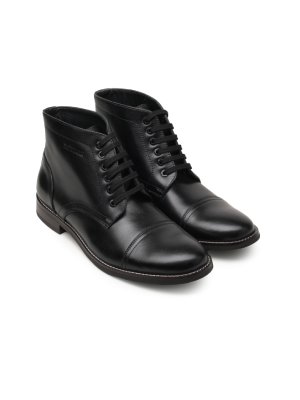Shoes were made from a variety of kinds of high-quality leather. The simplest shoes worn by artisans and farmers were made from thick heavy cowhide.
In the Novgorod cultural layer of the 11th-13th centuries, symmetrical footwear for both left and right feet were found with narrow heels [pjatka]. These finds also include shoes that have patterns, such as curly or parallel lines.
Shoe Craftsmanship
In the course of excavations in medieval towns in north-eastern Russia, archeologists found many pairs of footwear [lapti] decorated with various designs. Embellishment and leather stamping were the most common. They were the everyday shoes of the peasantry. They were worn with a tightening lace which wrapped around the ankle, and a sole that was attached.
To make one lapti, one requires seven pieces of bast each that measure two meters. To make the strips of a Linden tree, the bark had to be stripped off the entire surface of the tree without any flaws or rotting throughout the entire length. The early Russians used this metaphor: to stripe as if the bark of a tree.
Different regions have their own methods of making lapti. For instance, the Moscow ones were a bit high on the ankle, while those of the Northern regions were tucked in with pointed toes. Winter lapti were created using double layers of bast.
The shoemakers from Novgorod began to decorate their shoes in the 12th century with weaving patterns in woolen thread and leather. These patterns were various combinations of crosses, zigzags and triangles.
Leather Shoe Production
Literature has paid little focus on the craft of making shoes during medieval Novgorod. This is likely due to the extremely limitedness of archeological evidence that are our main source to study this subject.
All kinds of shoes were found at Novgorod archaeological sites. They are from the 10th to 14th centuries. The simplest, most basic shoes were made from thick dense leather, and were designed for a variety of people (artisans as well as farmers). For openwork-embroidered shoes, thinner and more flexible leathers were used.
Stamped designs on the surface of leather were created using embroidery or leather carving techniques. They included curly designs, rows of parallel or cross-over lines, as well as floral patterns. The most well-known openwork design was a pair of stylized flowers.
The footwear was also decorated with other embellishments, such as a pair eyes, a ribbon, bow, for instance. The soles were laced onto the shoe to safeguard the feet.
According to INE data, the production output in Russia rose in May 2022 compared to 2017. Shoes and leather were among the industries that boosted production. The increase was driven by the demand for footwear that is safe. The Russian company Vostok-Service>> manufactures safety footwear at its own production facilities – Torzhok Shoe Factory ZAO (Torzhok, Tver region) and Working Style>> OOO (Uzlovaya, Tula region). The company is a licensed distributor of the German Desma. Desma.

Traditional Techniques
In the 12th century, shoemaking was well established in Novgorod. From the time of at this point, shoes of different types, such as the bog shoe (lapti) ankle boots and shoes with high sides reaching the ankle (porshni), were discovered. All of these shoes were made from the linden bark of birch or oak bark, as well as elm. The bark was cut and then cut into strips that were then woven.
Depending on how the leather pieces were placed face-to-face or abutting one another and joined with or saddle stitching, or concealed stitches. Butt seams were used to join the upper leather piece to the lower piece when it abutted it. tachnyi shov, tachnyj shov].
Another type of winter footwear was burki (feather and felt boots) sewn from white felt. They were worn by upper-class individuals, such as Party leaders, military commanders generals, government officials and other high-ranking officers.
The 14th century saw the demise of simple openwork shoes, in favour of knee-high boots. They were distinguished by their narrow sections of the heel, tiny openings for threading laces, and holes or cuts in the bootlegs to accommodate decorative giay luoi nam cao cap leather straps. The cultural layer of Novgorod contains these types of shoes. They were fastened around the ankle with a lacing made of leather.
Modern Innovation
VV: I’m of the opinion that the sneaker culture in Russia is still pretty young. I believe it’s growing, and the market keeps expanding. It’s not as in the 90s, when sneakers were limited to a select few Moscow and Saint Petersburg residents who could pay for foreign brands.
The Russian footwear industry is trying to adapt modern technologies and trends through incorporating them into its manufacturing processes. For example, Obuv Rossii developed an automated system for manufacturing clogs and flip-flops using EVA with solid technology. This system is among the most advanced in its field.
The use of novel materials is also being evaluated by shoemakers. In addition, they are using the most recent IT solutions to enhance the omnichannel commerce and improve the loyalty of customers by providing an array of additional services.
The company will unveil and develop new shoe lines for women and children. It will be possible to buy shoes that are paired with bags, shoe care products and the hosiery. All these enhancements are expected to help increase sales, increase the complexity of purchases and boost customer loyalty.



